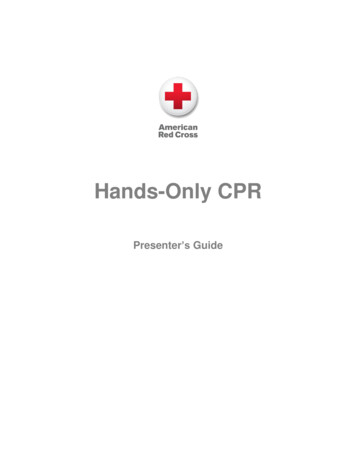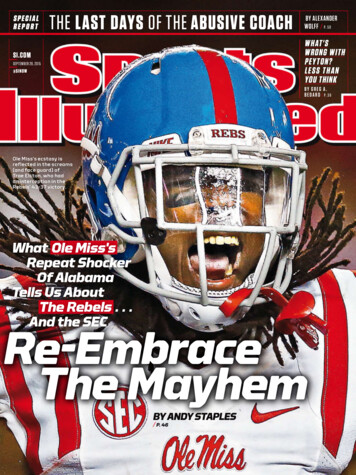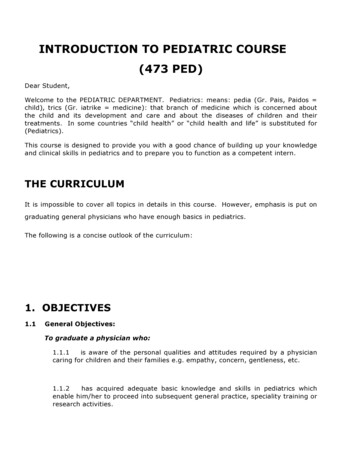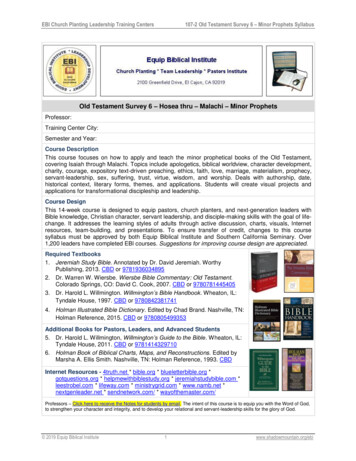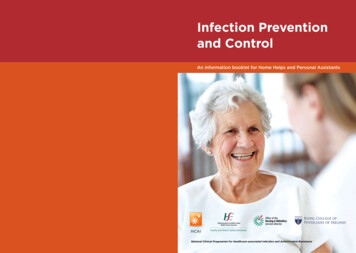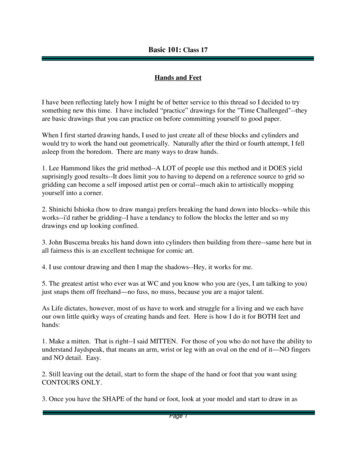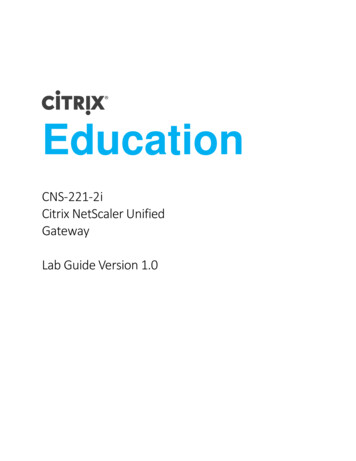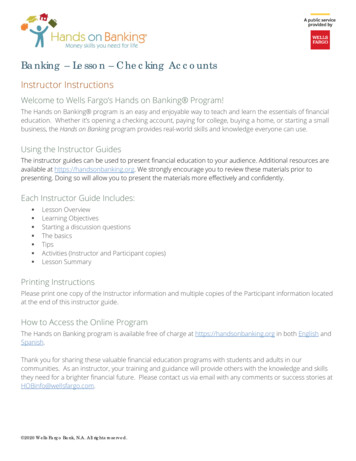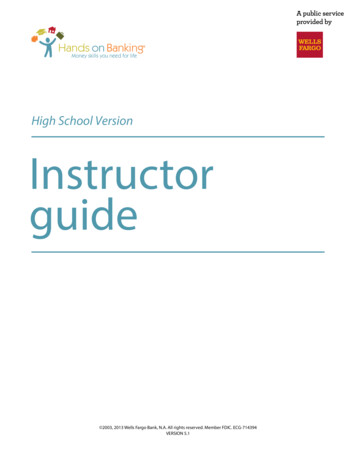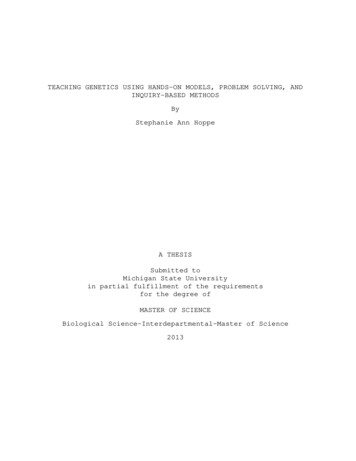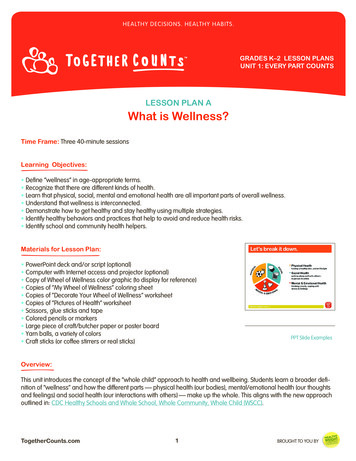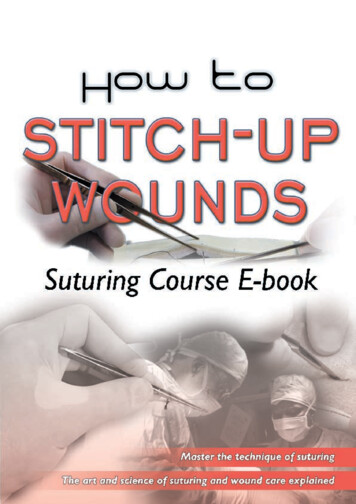
Transcription
AN ILLUSTRATED HANDS-ON COURSEAvailable for purchase:An 18 piece suturing Kit with all the instrumentsand items needed to learn how to suture lacerations!Learn how to care for- and suture wounds AND get your 18-piecesuture kit with real medical instruments and items – all you will needto practice wound suturing at home or wherever you are!!A product byTHE APPRENTICE CORPORATIONCopyright The Apprentice Corporation 2007All rights reserved.WARNING:The Apprentice Doctor Suturing Kit is exclusively intended foreducational purposes. It is strictly prohibited for use in medical situations.Not intended for treating either human or animal patients!
THE APPRENTICE CORPORATION: COPYRIGHT INFORMATIONAll copyright in and to the contents of The Apprentice Doctor CD–ROMs and web sites(including text, pictures, sketches, logos, animations, photographic material, video material, soundsamples and graphic art) are the sole property of The Apprentice Corporation and all the rights ofThe Apprentice Corporation are reserved.No part of The Apprentice Doctor CD–ROMs and web sites books or e-books may bereproduced or transmitted in any form or by any means without the express, written consent ofThe Apprentice Corporation.Contact information for writtenconsent may be requested from:The Apprentice Corporation2299 Kenmore AvenueBuffalo,NY 14207U.S.A.Or per e-mail: reg@TheApprenticeDoctor.comWe appreciate your integrity in this regard.
A BASIC COURSE IN SUTURINGCONTENTSINTRODUCTION01 - 05Preface.01Objectives of the Course.03Disclaimer.04List of Medical Instruments.05PREPARATORY PROJECTS09 - 20Case Study - Dr. Shipton’s Holiday.09Project 1: Familiarize yourself with the suture kit.11Project 2: Attach suture material to a needle.13Project 3: How to clip the needle to the needle holder.16Project 4: Prepare imitation skin for practicing suturing.18Project 5: How to construct a rod to practice knot tying.20BASIC KNOTS23 - 56Case Study - The Surgeons Knot.23Project Alpha: A demonstration of a square knot and a granny knot.25Project Beta: Make a square knot: Two-hand tie.29Project Gamma: Make a square knot: One-hand tie.33Project Delta: Make a surgeon’s knot: One-hand tie.41Project Epsilon: Make a square knot: Instrument tie.52Project Zeta: How to make a surgeon’s knot (Instrument tie).56SUTURING TECHNIQUES61 - 129Case Study - Rhodé’s Ear.61Case Study - Hazards at work.63Basic principles of wound care.65A basic course in suturing techniques.70Project A: How to place subcutaneous sutures.71Project B: How to place interrupted sutures.77Project C: How to place interrupted sutures with buried knots.85Project D: How to place continuous sutures.89
SUTURING TECHNIQUES (CONTINUE)Project E: How to place continuous interlocking sutures.93Project F: How to place horizontal mattress sutures.97Project G: How to place vertical mattress sutures.101Project H: How to place “Far-and-Near” sutures.105Project I: How to place subcuticular sutures.109Project J: How to place a purse string suture.115Project K: How to correct a “Dog’s Ear”.118Project L: How to correct unequal levels of tissue.121Project M: How to remove sutures.125Complications of suturing.129CONCLUSION131 - 132Epilogue.131Glossary.132
PREFACELearning how to suture wounds and lacerations requires a thorough understanding of the theory of woundcare and the basic principles of suturing. The student also needs to reach an advanced level ofproficiency by practicing knot tying and suturing techniques.The Apprentice Doctor Suture Course and Kit is not intended to substitute the clinical training of studentsbut rather to offer a firm foundation and an opportunity to experience his/her initial learning curve in animitation situation – so as to fill the student with confidence when he is faced with the real life clinicalsituation.The Apprentice Doctor Suturing course material consists of 3 sections:1. Get acquainted with the instruments and items in the Kit2. Basic Knot tying3. Suturing techniquesFollow this specific order when working your way through the course material, and ensure that you understandthe one section and are able to perform the practical projects skillfully before proceeding to the next section.Do not skip a section because you think it is unimportant or too simple. Basic principles are like that, theyappear to be simple, but one needs to understand and practice these simple building blocks before proceedingto, and succeeding with the complicated stuff.IMPORTANT NOTES:Kindly note: For the purpose of this course the word suture will be used as the verb/noun pertaining to theclosing-up or stitching-up of wounds/lacerations /incisions. The Apprentice Doctor Suturing Hands-on Course and Kit has been designed mainly for right-handedpersons. Left-handed persons please exchange the terms left and right as they occur in the text whereIntroductionapplicable.1 This Kit contains the bulk of the information, instruments and items to successfully practice your suturingtechnique. It is highly recommended that you invest in The Apprentice Doctor Basic Medical Course andKit, which wonderfully supplements The Apprentice Doctor Suturing Course and Kit!The Apprentice Doctor E-book
TheApprenticeDoctor.com website and community compliments these 2 products and gives the futureHealthcare professional a chance to join groups of like-minded students with the aspiration of becomingmedical professionals, or to learn from other practicing Healthcare professionals. You will find a suitablecommunity in your country/state – and will receive lots of free advice and support to help you fulfill your dream!Dr Anton Scheepers and the staff of The Apprentice Corporation as well as all the Apprentice Doctorcommunity leaders would like to wish you success with your future and look forward to being a small part offulfilling your dreams!Recommended training material for All Healthcare Professionals whether prospective, in training or qualified: Medical students Pre-medical students Paramedics and EMT students Dental students Veterinary students Nursing students Surgery Interns/Registrars Advanced First Aid practitioners Medics in the military The Apprentice Doctors’ Club Members High school students interested in a career in medicine Practicing Healthcare professionals who would like to improve or refresh their suturing technique.Preface Non-medically qualified individuals with a keen interest in the practical aspects of medicineThe Apprentice Doctor E-book2
OBJECTIVES OF THE COURSE:To equip students with a basic understanding of the theory of suturing wounds and to acquire the skills toconfidently tie surgical knots and suture lacerations.The student should on completion of this course have a good understanding of: The basic principles of wound care Knot tying techniques (as related to knots used in surgery) Surgical instruments used in suturing Suture materials The various suturing techniques used by medical professionalsThe student should have the following skills: Placing sub-cutaneous sutures Placing interrupted sutures Placing a variety of mattress sutures Tying a square knot (two-hand tie, one-hand tie, and instrument tie) Tying a surgeon’s knot (one-hand tie, and instrument tie) Using a number of other types of suturing techniques Correcting minor discrepancies while suturing Removing suturesDeveloped by a surgeon with more than 20 years of experiencePLEASE READ THESE WARNINGS CAREFULLY Your Suture and Dissection Kit contains sharp objects e.g. a scalpel-like knife, needles and scissors. Please be extremelycautious and careful when using these instruments! Not suitable for children under 12 years of age! Supervision/guidance by a responsible adult is recommended for students under 18 years of age. The user must always wash his/her hands before using the kit to minimize the risk of infection following accidental injury.For the same reason gloving is recommended. Always use clean instruments. Wash instruments with soap and water after each usage session, then leave it in anIntroductionantiseptic solution e.g. Savlon for 60 minutes. Rinse thoroughly with clean water then dry before replacing it in the kit.3 For any cut or needle prick injuries – squeeze the wound for 15-30 seconds to bleed out impurities, then washprofusely with soap and water; apply pressure to stop the bleeding, then apply a plaster e.g. Band Aid. Seek professionalmedical assistance. Keep out of reach of babies, toddlers and children under the age of 10. Keep sharp instruments away from the eyes.The Apprentice Doctor E-book
DISCLAIMERThe producer or supplier of this application does not: Offer any warranty regarding the accuracy or correctness of any information contained in this application; Assume any responsibility for any damage or consequential damage related in any way to the information,instrumentation or items contained in this product/application or as a result of the use thereof.The user takes full and exclusive responsibility for the safe application of any information contained in thisapplication. The user also takes full and exclusive responsibility for all safety aspects related in any way to theuse of any instrument or item supplied with this application. This exclusive responsibility applies equally to theuser or to any person or persons being supervised by the user.No warranties are offered on the functional status or fitness for a specific application of any information,instrument or item supplied in this application.The supplier accepts no responsibility for the malfunction of any instrument or item.The supplier disclaims all liability for any direct or indirect damages – specific or consequential - related in anyway to the information, and instrumentation or any item contained in this application.All practical exercises are performed exclusively at the user’s own risk. The producer or supplier of thisapplication disclaims any responsibility for any medical emergencies, medical problems or any other problemswhatsoever, which may arise while using any instrument or item or applying any information supplied with thisapplication.The use of the instruments, items and information supplied in this application is conditional upon theacceptance of this disclaimer as well as the undertaking to honor the copyrighted course material.REIMBURSEMENT POLICYThe Apprentice Corporation is confident that you will be satisfied with this product in each and every way.If you are, for any reason dissatisfied with your choice, The Apprentice Corporation will be happy toreimburse you (less postage and shipping charges) should you wish to return the complete medical kit as wellas the CD-ROM in an undamaged state within a reasonable time limit of not more than 8 weeks after acquiringYOUR ORDER NUMBER AND THE DATE OF THE TRANSACTIONSHOULD ACCOMPANY YOUR REQUEST FOR REIMBURSEMENT.The Apprentice Doctor E-bookDisclaimerthis product.4
LIST OF MEDICAL INSTRUMENTSSurgical scissorsSurgical scissors are classified according to the 2 blade tips - thus: Sharp–sharp Sharp–blunt Blunt–bluntSometimes scissors are classified according to function – for example: Suture cutting scissors Dissection scissorsIn certain operations it is safer to carefully dissect your way towardsan area/organ rather than cutting into the tissues with a sharp scalpelblade.Use your medium Sharp–blunt scissors for general cutting purposesand to cut off excess suture material after placing a suture and tying the knot.Use the small Sharp-sharp scissors to cut the suture for removal.Surgical probes (seekers)Your Kit has two probes: Sharp (straight) Blunt (slightly curved)Probes are also classified as: Hollow SolidA dentist uses a sharp curved probe to examine teeth and detectcavities.IntroductionAnesthetists and radiologists use flexible blunt probes to maneuver5their way into specific veins or arteries in the body (for diagnostic ortherapeutic purposes)The Apprentice Doctor E-book
Skin hook (if available)A skin hook is used to lift a section of skin, to facilitate the placement ofsutures while minimizing the amount of injury to the tissues.By placing two skin hooks into the tissue at the corners on the 2 sidesof a laceration, and gently lifting both skin hooks, one can facilitateeversion (having a slightly raised sutured laceration compared to theadjacent tissue).ScalpelA scalpel is a surgical knife with a fixed or removable blade(cutting area). Removable blades are produced in a variety ofpatterns and sizes.WARNING: The scalpel is the most dangerous instrument in your Kit –handle with caution!ForcepsA forceps is an instrument used in medicine to grab or to holdsomething.You Kit contains a general-purpose tweezer-forceps. The inside ofthe tips (jaws) are serrated to enhance gripping. This forceps is usedfor general handling and gripping of tissue or objects.The other forceps is called a tissue forceps. The tip of this forcepsshows a sharpish tip (jaws) on the one leg and a v-shaped groove onthe other side. It is commonly referred to as a rat-tooth forceps.List of Medical InstrumentsUse this forceps to handle tissue when placing sutures.Needle HolderA Needle Holder is a special type of forceps, designed to securely holdthe surgical suture needle when placing sutures.Artery forceps are somewhat similar in appearance, but have longerjaws – some with straight and some with curved jaws.The Apprentice Doctor E-book6
SuturesThe main two groups of sutures are: Absorbable.These sutures are broken down by bodily enzymes, and are usedwhen sutures are placed within the body, below the skin(Chromic and Plain Catgut, Vicryl and Monocryl ) Non-absorbable (e.g. Nylon and Silk).These sutures are more predictable as regards their strength. The patient needs to return to thehospital/surgery for removal of these sutures.Sutures may also be subdivided as braided and monofilament. As a rule, braided sutures are easier to tie butcause a more intense tissue reaction.Suture sizesModern suture diameters range from thick to thin and are represented by the series of numbers 5, 4, 3, 1, 0,2-0, 3-0, 4-0, 5-0, 6-0, 7-0, 8-0, 9-0, 10-0 and 11-0. Number 5 sutures are heavy braided sutures used byorthopedic surgeons and 11-0 sutures are micro-fine monofilament sutures used by ophthalmic surgeonsoperating with the aid of a surgical microscope. Number 5-0 or 6-0 sutures are used to stitch up lacerations incosmetically sensitive areas like the face.NeedlesNeedles may be straight, a semi-circle or a section thereof. In crosssection they may be round or triangular – with a cutting edge on eitherthe inner curve or the outer curve.The length and the diameter of needles may vary considerably.The number used when describing a needle usually refers to the lengthin millimeters.Modern needles are pre-assembled with a suitable suture materialattached to the blunt end. These needles are referred to as “atraumatic”- meaning they do not have an eye that may injure the tissue as itIntroductiontraverses the tissues.7The needles in your Kit have a small eye on the side opposite to the tipfor you to attach the suture to. Atraumatic needles are manufactured in all shapes for most sizes of sutures.The Apprentice Doctor E-book
Imitation SkinA 15 X 15 cm imitation skin is included in your kit. The white fiber-likepart corresponds to the dermis and the thin plastic coveringcorresponds to the epithelium (the covering surface layer of skin andmucous membranes).Remember you can practice your skills on a variety of vegetables –oranges, bananas potatoes etc.The imitation skin in your kit is more life-like compared to a number of gel-like imitation skin products availableon the market. Skin is in fact anything but gel-like in consistency.GlovesIt is strongly recommended that you wash your hands hygienicallyclean (see “Project 00” in The Apprentice Doctor Basic MedicalCourse) and glove before practicing placing sutures to make surethat you get in the right habits from the word go. You need to becomeaccustomed to the “feel” of working while being gloved like a surgeon.List of Medical InstrumentsMore information: http://en.wikipedia.org/wiki/SutureThe Apprentice Doctor E-book8
DR SHIPTON’S HOLIDAYDr Shipton usually reserves 2 weeks at their favorite holiday resortfor their family’s yearly holiday. Dr Shipton, his wife and their twochildren look forward to these 2 weeks of enjoyment months inadvance. It is a time of re-uniting family ties, involving the wholefamily in games and activities, all at a beachfront venue, with theirflat having an exceptionally great view of the treacherous IndianOcean on the East coast of Africa.The first week was great. The weather was good and the sea wasperfect for swimming. “Let’s get up early tomorrow morning andwatch the fishermen reeling in their fish from the rocks,”Jamie the elder Shipton son proposes, and the proposal is acceptedunanimously. It is July and one of the most spectacular naturalevents is about to occur – the sardine run. Schools of millions ofsardines migrate up the coast, followed by game fish likebarracudas and sharks in their thousands – a fishermen’s paradise!!Conditions for fishing have been forecast as optimal and hundredsof fishermen line the coast, the prime spot is Ekhakha’s rock. Dr Shipton and his family haven’t caught on tothe fishing thing, but this event makes for great entertainment merely by being a spectator.So 8 a.m. and everybody’s ready to stroll down to the beach. They have to pass a number of neighboring flatson their way down. Suddenly they are stopped in their tracks, stunned by screaming followed by an urgentshout: “HELP! SOMEBODY, PLEASE HELP!!” One of their neighbors’ flat door swings open with an even moreurgent shout for help.Dr Shipton dashes towards the flat and discovers the neighbor’s17-year-old son covered in blood. A simple slip and his headshattered the glass top on the coffee table. “Quickly bring metowels!” he shouts. He tightly drapes a large towel over the largeCase Studycut in the scalp and puts on tight hand pressure for a couple of9minutes. The towel slowly becomes red and more saturated withbright red blood.The Apprentice Doctor E-book
The pressure helps but doesn’t stop the bleeding. “Go get my first aid kit!” His wife rushes to their flat andreturns with the kit. Dr Shipton always carries some local anesthetic as well as a couple of packets of suturematerial and the relevant instruments in his first aid kit. He quickly injects local anesthetic containing adrenalinand almost immediately starts to stitch up the long 25 cm (10 inch) laceration in the scalp.With each stitch the bleeding gets less. Dr Shipton doesn’t wastetime cutting the stitches – just one long continuous suture. Time isof the essence. He has just one thing in mind to stop thebleeding as soon as possible. He takes fairly large bites with thesuture needle into the tissue adjacent to the laceration, andensures that the stitches are tight by interlocking them. He usesanother towel to clean up the wound. He then inspects the areafor residual bleeding, and cleans up.Dr Shipton writes a note to the Medical Officer at the localhospital giving him the relevant information and requesting himto take over the case. Just then, the ambulance arrives and theParamedics rush to assist in stabilizing the patient. The patient istransported to the local hospital.At long last the Shipton family is on their way to the beach – thesubject under discussion is the events of the morning.Would you like to be prepared for an emergency situation like Professor Shipton? Here is your chanceto learn how to professionally suture wounds!For those who are not qualified and officially registered as a medical professional, please keep the following inmind: Leave suturing on real patients to suitably medically qualified individuals. In an emergency call 911 or equivalent emergency number! Exert direct pressure on any bleeding point until help arrives.The Apprentice Doctor E-bookDr Shipton’s HolidayIMPORTANT WARNING10
PROJECT 1 - FAMILIARIZE YOURSELF WITH THE SUTURE KITEnsure that your Suture Kit is complete and that you know the names of each individual instrumentINFORMATIONMost metal surgical instruments are made from stainless steel – which is strong, durable and won’t corrode(rust). They can be sterilized by steam autoclaving and will retain their characteristics.REQUIREMENTSYour suture KitSTEP 1Identify the components of your suture Kit using the list(provided on page 5). Our Kits are double checked for quality andcompleteness by our factory. In the unlikely event of problems,kindly contact customer support personnel atCustomercare@TheApprenticeDoctor.com.STEP 22.1 Remove the Needle Holder from the Kit, and examine it. Identify itsdifferent parts.2.2 Have a good look at the ratchet latch (lock) mechanism - it has 3beveled teeth on the inside of both sides – designed to catch at 3 levels– light, medium and strong locking.Preparatory Projects2.3 Put the thumb in the upper eye and the 4th finger in the lower eye11of the handle – see picture right. Practice the locking and unlockingaction of the ratchet latch mechanismat all three levels.2.4 Clamp and unclamp small objects like pieces of paper or thincardboard. Do the jaws leave a checked pattern on the paper?The Apprentice Doctor E-book
2.5 Now examine the crosshatched pattern (photo) on the inner sideof the Needle Holder’s jaws. This pattern is designed to firmly gripthe suture needle and prevent unnecessary slipping of theneedle/suture. Wear and tear will eventually cause this surface tobecome smooth – an indication to replace the Needle Holder with anew one.STEP 3Remove the two tweezerforceps from the set. Theforceps has two legs joinedat the hinge. Examine theinside of the tips. The oneforceps has jaws with aserrated inner surface andthe other one has a v-shaped tooth on the inside of the jaw and a v-shaped groove on the other side (the toothSTEP 4Have a look at the skin hook (substituted with a sharp curvedprobe in some sets). It is used to gently lift skin during suturing.Hook the skin on the inside (raw) surface – not the epithelialsurface.POINTS OF INTEREST1. Quite a variety of scissors each with a unique purpose are available. Examples are: A pair of scissors that can cut through stainless steel wire – used byorthopedic surgeons and maxillofacial surgeons A pair of dissection scissors – meant to carefully dissect through tissueinstead of cutting with a scalpel. These scissors are usually slightlycurved with pointed, though slightly rounded tips Micro scissors – used in eye surgery and microscopic surgeryA pair of micro scissors(e.g. joining small arteries, veins and nerves under the surgical microscope)The Apprentice Doctor E-bookProject 1: Familiarize yourself with the Suture Kitfitting into the groove). Use this forceps to gently handle tissue with the left hand when placing sutures.12
2. A surgeon is only as good as his/her tools. Know your instruments and always use good quality medicalinstruments. Order affordable quality medical instruments at: http://www.affordabledrtools.com/3. Order a professional suture set (IFRC specifications): http://www.affordabledrtools.com/PROJECT 2 - ATTACH SUTURE MATERIAL TO A NEEDLEHow to attach a piece of suture material to a surgical needleINFORMATIONIn past generations, a medical professional would routinely use a needle with an eye (an “eye” is a small holeon the blunt side of a needle where the thread is held) for suturing purposes. The eye part of such a needlemay cause minimal damage as it traverses the tissue.Modern suturing materials have pre-attached thread. Pre-attachedsutures allow for a smooth transition from the needle’s body to theswage and then to the suture – and are thus referred to as an“atraumatic design” (won’t cause further injury to the tissue).The needle-suture attachment is an occasional weak link, and onrare occasions may become undone. This attachment occupies about⅛ inch (3 mm) on the suture end of the needle (the swage).One should avoid clamping the Needle Holder to the swage of theneedle as one may interfere with the secure attachment of the sutureto the needle.Suppose you land yourself up in a far-off mission hospital or a military field hospital and you only have threadand needles with eyes – will you be able to help your patient? Learn how to attach suture material to a needlePreparatory Projectsby following these steps:13REQUIREMENTSYou will need: About (12-18 inches) 45 cm of silk suture One no 16 semicircular needleThe Apprentice Doctor E-book
STEP 1Unroll about 12-16 inches (30-40 cm) of silk suturefrom one of the reels supplied.STEP 2Remove one no 16 needle from the package using theNeedle Holder. Clamp the needle roughly in the middleof the needle’s body. Secure the Needle Holder byclamping it to the first ratchet. (Be careful whenworking with sharp objects).STEP 3Fold the last 1½-inch (4 cm) of suture double and passSTEP 4Open up the double thread slightly to form a loop, andpass the needle through the loop.The Apprentice Doctor E-bookProject 2: Attach suture material to a needlethe double thread through the eye of the suture needle.14
STEP 5Firmly pull the long and short loose ends of the doublethread away from the needle - thus tightening thesimple loop knot to attach the thread to the needle.POINTS OF INTEREST1. Needles with eyes can be re-used a couple of times under the following conditions: The tips remain sharp The needles are structurally undamaged They are properly sterilized Re-use for not more than 4-6 times2. Practice and perfect your technique by ordering a variety of real pre-assembled, pre-packed sterilePreparatory Projectssurgical sutures from http://www.affordabledrtools.com/15The Apprentice Doctor E-book
PROJECT 3 - HOW TO CLIP THE NEEDLE TO THE NEEDLE HOLDERLearn the technique on how to properly clip and secure a needle onto a Needle HolderINFORMATIONNote: One should ideally clip the Needle Holder onto the mid-section of the needle – somewhat closer to theProject 3: How to clip the needle to the Needle holderswage. Avoid clipping the Needle Holder onto either the Tip or swage sections!The various parts of a surgical needleREQUIREMENTS The Needle Holder One no 16 Needle with suture material attached (see Project 2)The Apprentice Doctor E-book16
STEP 1Wash your hands, dry and put on a pair of gloves(Project 00 of The Apprentice Doctor BasicMedical Course). The Gloves serve as a surgicalbarrier between operator and patient, and provideprotection from accidental needle injuries. Doublegloving is advised for high-risk patients e.g. patientswith Hepatitis B and HIV infections.STEP 2Follow the principle of minimal handling of sharpinstruments and items. Use a tweezer-forceps toremove one no 16 needle from the package using yourleft hand. Present the needle to the needle holder withthis tweezers forceps.STEP 3Use your needle holder to clip the needle, secure thelatch mechanism (listen for the first or second “click”)– avoid clipping it onto the swage third (may damag
Tying a square knot (two-hand tie, one-hand tie, and instrument tie) Tying a surgeon’s knot (one-hand tie, and instrument tie) Using a number of other types of suturing techniques Correcting minor discrepancies while suturing Removing sutures Dev
